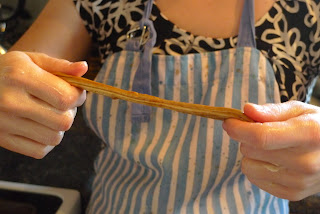The Month of December is dedicated to the Divine Infancy.
"Mary wraps up a small bundle of clothes for the use of her little Son, and then, going to the crib, she says with tears in her eyes to her sleeping Child, 'O my Son, and my God! Thou hast come from heaven to save men; but hardly art Thou born when they seek to take Thy life.'" ~ 2010 Catholic Calendar
December 3rd, St. Francis Xavier (New, Trad.):
- St. Francis Xavier - December 3 (Polla a la Vasca- Basque Chicken with Pimiento)
- Xaver Suppe (Soup for St. Francis Xavier's Day)
December 6th, St. Nicholas of Myra (New, Trad.):
- Upcoming From Thy Bounty Fair, St. Nicholas (includes links and ideas)
- From Thy Bounty Fair, St. Nicholas (more links and ideas!)
- St. Joseph's Staff (Candy Cane Cookie Recipe)
- Candy Cane Coffee Cake
- Christmas Honey Cookies for the "Honey-Tongued" Saint
- Sweet Beehive Cake for St. Ambrose
- Bumblebee Cookies for St. Ambrose
December 8, The Immaculate Conception (New, Trad.):
- Meal Ideas for the feast of the Immaculate Conception
- Blueberry Muffins for Our Lady
- Mary's Immaculate Conception (A complete dinner menu!)
December 9th, St. Juan Diego (New):
- Mexican Chocolate Cake
- Una Fiesta Mexicana
- Rosy Treats for the Feasts of St. Juan Diego and Our Lady of Guadalupe
- Mexican Sopapias for St. Juan Diego and Our Lady of Guadalupe
- Fish Tacos for Friday
- Cheese Enchiladas
- Our Lady of Guadalupe ~ Mexican Wedding Cookies
December 12th, Our Lady of Guadalupe (New, Trad.):
December 13th, St. Lucy or Santa Lucia Day (New, Trad.):
December 17th thru 23rd, O Antiphons (New, Trad.):
December 24th, Vigil of Christmas (Trad.):
December 25th, Christmas - The Birth of Our Lord Jesus Christ (New, Trad.):
- From Thy Bounty Fair - Holiday Foods and Feasts!
- First Holy Communion Breads
- Staples of Our Feast Day Celebrations Part One: Bread
- Staples of Our Feast Day Celebrations Part Two: Wine
- Mealtime Prayers for Christmas
- Christmas Panettone
- Lamb of God (Rolls)
December 27th, St. John the Apostle (New, Trad.):
December 28th, The Holy Innocents (New, Trad.):
- Christ's Diapers
- Feast of the Holy Innocents (Coconut Rice Pudding with Raspberry Sauce)
December 31st, New Year's Eve :
MORE RECIPES FOR ADVENT:
Throughout Advent :
First Sunday of Advent ~ Stir-Up Sunday :
Second Sunday of Advent :
Pin It
First Sunday of Advent ~ Stir-Up Sunday :
Second Sunday of Advent :
- Grasshoppers and Honey
- Grasshopper Parfaits
- St. John the Baptist Locust and Honey Snack
- St. John the Baptist ~ Locust & Honey
St. Andrew's Christmas Novena
Hail, and blessed be the hour and moment at which the Son of God was born of a most pure Virgin at a stable at midnight in Bethlehem in the piercing cold. At that hour vouchsafe, I beseech Thee, to hear my prayers and grant my desires. (Mention your intentions here) Through Jesus Christ and His most Blessed Mother. Amen.
Say 15 times a day from St. Andrew's Day (30 November),
ending on Christmas Eve



.JPG)








.jpg)












 Enjoy an easy and symbolic treat on St. Andrew's feast day - November 30. Set out a bowl or basket of pretzel "fishing rods" (any stick variety will do, whether thin sticks or rods). Accompany this with a smaller bowl of peanut butter, cheese dip, cream cheese spread (anything that will stick to the pretzel sticks) and a bowl of gold fish crackers. Commence fishing by dipping the pretzel sticks in the peanut butter (or other dip option) and then catch a “fish” from the fish bowl as the crackers will stick to the rod of peanut butter.
Enjoy an easy and symbolic treat on St. Andrew's feast day - November 30. Set out a bowl or basket of pretzel "fishing rods" (any stick variety will do, whether thin sticks or rods). Accompany this with a smaller bowl of peanut butter, cheese dip, cream cheese spread (anything that will stick to the pretzel sticks) and a bowl of gold fish crackers. Commence fishing by dipping the pretzel sticks in the peanut butter (or other dip option) and then catch a “fish” from the fish bowl as the crackers will stick to the rod of peanut butter.



























